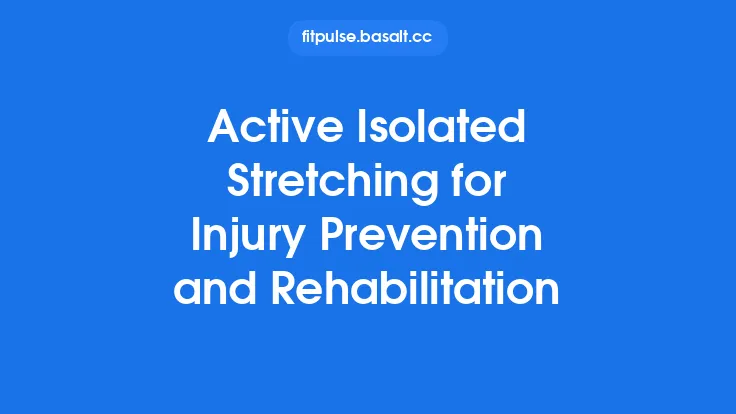Rotator cuff tears are among the most common shoulder injuries faced by athletes, recreational exercisers, and individuals whose daily activities involve overhead motions. While surgical repair may be necessary for large or retracted tears, many patients achieve excellent functional outcomes through a well‑structured, non‑operative rehabilitation program. This guide consolidates timeless principles and evidence‑based strategies that can be applied regardless of the specific tear size, patient age, or activity level. By understanding the anatomy, respecting the biology of healing, and progressing methodically through each phase, you can restore strength, stability, and range of motion (ROM) while minimizing the risk of re‑injury.
Understanding Rotator Cuff Anatomy and Common Tear Types
The rotator cuff is a synergistic group of four muscles—supraspinatus, infraspinatus, teres minor, and subscapularis—whose tendons converge to form a cuff around the humeral head. Their primary roles are to center the humeral head within the glenoid fossa and to generate controlled shoulder motion, especially during elevation and rotation.
Key anatomical considerations
| Structure | Primary Function | Typical Injury Mechanism |
|---|---|---|
| Supraspinatus | Initiates arm abduction (0‑15°) | Impingement under the acromion, especially in overhead athletes |
| Infraspinatus | External rotation | Traction injuries, repetitive loading |
| Teres Minor | External rotation, adduction | Less commonly isolated; often involved in larger tears |
| Subscapularis | Internal rotation, anterior stability | Forced external rotation or anterior dislocation |
Tear classifications
- Partial‑thickness tears – Involve only a portion of the tendon thickness; often managed conservatively.
- Full‑thickness tears – Extend through the entire tendon; may be treated non‑operatively if the patient has low functional demands or the tear is small.
- Acute traumatic tears – Result from a sudden overload (e.g., fall on an outstretched arm).
- Degenerative tears – Develop over time due to chronic overuse, age‑related tendon degeneration, or microvascular insufficiency.
Understanding which tendon(s) are involved guides exercise selection and progression, as each muscle contributes uniquely to shoulder mechanics.
Initial Phase: Protecting the Healing Tissue
The first 1–2 weeks after injury or surgery focus on protecting the repaired or inflamed tendon while controlling pain and inflammation.
Goals
- Maintain shoulder positioning that reduces tensile stress on the cuff.
- Prevent stiffness in adjacent joints (e.g., scapulothoracic articulation, elbow, wrist).
- Initiate gentle neuromuscular activation without loading the tendon.
Key interventions
- Immobilization: A sling or abduction pillow set at 30–45° of abduction and slight external rotation can off‑load the supraspinatus and subscapularis. Duration depends on tear size and surgical protocol; for non‑operative cases, immobilization is often limited to 1 week to avoid adhesive capsulitis.
- Cryotherapy: Apply ice packs for 15–20 minutes, 3–4 times daily, to reduce swelling and nociceptive input.
- Passive ROM (PROM) within safe limits: Gentle pendulum exercises and assisted flexion/abduction up to 90° (if pain‑free) keep the joint mobile without stressing the cuff.
- Isometric activation: Light isometric contractions of the rotator cuff (e.g., submaximal “thumb‑up” external rotation against a wall) can maintain motor unit recruitment while the tendon remains protected.
Early Mobility and Gentle Activation
From week 2 to week 6, the emphasis shifts to restoring functional ROM and initiating low‑load muscular activation.
Range‑of‑motion priorities
- Scapular mobility – Scapular upward rotation, posterior tilt, and external rotation are essential for full shoulder elevation. Perform scapular wall slides and “Y‑T‑W” patterns without resistance.
- Glenohumeral flexion/abduction – Progress from assisted to active‑assisted movements, aiming for 120° of flexion and abduction by week 4.
- External rotation – Begin with supine or side‑lying “empty can” external rotation using a light stick or cane for proprioceptive feedback.
Activation exercises
| Exercise | Position | Load | Reps/Sets |
|---|---|---|---|
| Supine “empty can” (0 kg) | Lying on back, arm at 90° abduction, thumb down | Body weight only | 2 × 10 |
| Side‑lying external rotation (no weight) | Lying on non‑affected side, elbow flexed 90° | Gravity only | 2 × 12 |
| Scapular retraction with a towel roll | Seated, arms at sides | Light resistance (towel) | 2 × 15 |
The focus is on quality of movement—smooth, pain‑free arcs with the scapula moving in synchrony with the humerus. Any sharp pain or excessive fatigue should prompt a return to the previous tolerated level.
Strengthening Phase: Building Resilience
Weeks 6–12 mark the transition to progressive resistance training. The tendon’s biological healing phase (collagen remodeling) is now robust enough to tolerate moderate loads, provided the loading is gradual and controlled.
Principles of load progression
- Incremental overload: Increase resistance by ≤ 10 % per week.
- Specificity: Target each rotator cuff muscle with motions that mimic its functional line of pull.
- Balanced development: Pair internal‑rotation strengthening with external‑rotation work to avoid muscular imbalances that predispose to re‑tear.
Core strengthening set
| Exercise | Position | Load | Tempo | Reps/Sets |
|---|---|---|---|---|
| Prone “Y” (targeting lower trapezius) | Prone, arms overhead, thumbs up | Light dumbbell (1–2 kg) | 2 s up, 3 s down | 3 × 12 |
| Standing external rotation with cable (or pulley) | Elbow at 90°, forearm across abdomen | Light cable tension (5–10 lb) | 3 s concentric, 3 s eccentric | 3 × 10 |
| Internal rotation with resistance band (light) | Elbow at 90°, forearm across abdomen | Light band (yellow) | 2 s up, 2 s down | 3 × 12 |
| Scaption with dumbbell (supraspinatus) | Standing, arm in scapular plane, thumb up | 2–4 kg | 2 s up, 3 s down | 3 × 10 |
| Closed‑chain “push‑up plus” (serratus anterior) | Hands on wall or bench, protract scapula at top | Body weight | 2 s up, 2 s down | 3 × 8 |
Eccentric emphasis – Incorporating controlled eccentric loading (e.g., lowering phase of external rotation) has been shown to stimulate collagen alignment and improve tendon tensile strength.
Advanced Conditioning and Sport‑Specific Drills
From week 12 onward, the program evolves to incorporate higher‑velocity, power‑oriented, and sport‑specific movements. The goal is to re‑establish the kinetic chain integration required for overhead activities such as throwing, serving, or swimming.
Dynamic stabilization drills
- Plyometric “medicine ball toss” – Light ball (1–2 kg) tossed from chest to overhead, emphasizing rapid scapular upward rotation.
- Cable “rotational punch” – Standing, torso rotated away from the working arm, then explosively rotate back while extending the arm, mimicking a punching motion.
- Resistance‑band “external rotation sprint” – Short bursts of maximal external rotation against a medium‑resistance band, followed by a brief rest.
Functional integration
- Closed‑chain overhead press – Using a Smith machine or a stable barbell, press from shoulder height to full extension while maintaining scapular control.
- Weighted “empty can” with tempo – 3 s concentric, 3 s eccentric, using a moderate load (4–6 kg) to develop endurance.
- Sport‑specific simulation – For baseball pitchers, incorporate “long toss” drills with progressive distance; for swimmers, perform “dry‑land pull‑outs” that replicate the underwater pull phase.
Neuromuscular timing – Although detailed neuromuscular re‑education is covered in a separate article, it remains essential to practice coordinated timing between the rotator cuff and the larger shoulder girdle muscles during these advanced drills.
Adjunct Therapies and Pain Management
Complementary modalities can accelerate recovery, reduce discomfort, and improve tissue quality when used judiciously.
- Therapeutic ultrasound – Low‑intensity pulsed ultrasound may enhance collagen synthesis during the remodeling phase.
- Manual therapy – Soft‑tissue mobilization of the posterior capsule and scapular mobilizations improve glide and reduce compensatory patterns.
- Progressive stretching – Gentle sleeper stretch for posterior capsule, held for 30 seconds, 3 times daily, helps maintain external rotation.
- Anti‑inflammatory strategies – Short courses of NSAIDs (as directed by a physician) can control pain during the early phases; however, prolonged use may impede collagen formation, so taper as soon as feasible.
Criteria for Progression and Return to Activity
Advancing to the next phase should be based on functional milestones rather than a fixed calendar. The following checkpoints are widely accepted:
- Pain‑free ROM – Full, pain‑free active ROM in all planes.
- Strength symmetry – At least 85 % strength of the contralateral side on handheld dynamometry for external rotation and abduction.
- Control of scapular kinematics – No observable winging or dysrhythm during overhead movements.
- Functional tolerance – Ability to perform sport‑specific drills (e.g., 10 consecutive throws) without pain or loss of form.
- Patient confidence – Subjective readiness scores (e.g., a 0–10 scale) ≥ 8.
Only when these criteria are consistently met should the athlete progress to unrestricted sport participation or heavy occupational tasks.
Common Pitfalls and How to Avoid Them
| Pitfall | Why It Happens | Prevention |
|---|---|---|
| Early aggressive loading | Desire to “get back” quickly | Follow the graduated load schedule; respect pain signals |
| Neglecting scapular mechanics | Focus solely on cuff muscles | Include scapular stabilization drills in every session |
| Overreliance on pain medication | To mask discomfort | Use medication sparingly; prioritize active recovery |
| Skipping eccentric work | Belief it’s unnecessary | Incorporate controlled eccentric phases for tendon remodeling |
| Inconsistent exercise frequency | Busy schedules | Schedule short, frequent sessions (e.g., 5 × 10 min) rather than occasional long workouts |
Creating a Sustainable Home Program
Even after formal therapy concludes, maintaining rotator cuff health requires a concise, evidence‑based routine that can be performed with minimal equipment.
Sample 3‑day weekly plan
- Day 1 – Scapular wall slides (2 × 15), side‑lying external rotation (3 × 12), prone “Y” (2 × 12)
- Day 2 – Light dumbbell scaption (3 × 10), standing internal rotation with light band (3 × 12), “empty can” with moderate weight (2 × 10)
- Day 3 – Dynamic “medicine ball toss” (3 × 8), cable external rotation (if available) or banded eccentric external rotation (3 × 10), push‑up plus (2 × 8)
Progress by adding 0.5–1 kg to dumbbells or increasing band tension every 2–3 weeks, provided technique remains flawless.
When to Seek Professional Intervention
While many rotator cuff tears respond well to structured rehabilitation, certain red flags warrant prompt evaluation by a qualified orthopedic specialist or physical therapist:
- Persistent night pain that awakens you from sleep.
- Sudden loss of strength or a “popping” sensation during activity.
- Visible deformity or swelling that does not subside with rest and ice.
- Inability to achieve functional ROM despite diligent home exercises.
Early identification of complications—such as a re‑tear, adhesive capsulitis, or secondary impingement—allows for timely adjustments to the treatment plan, which may include imaging, surgical consultation, or a modified rehab protocol.
By adhering to these timeless principles—respecting tissue biology, progressing methodically, and integrating functional movement patterns—you can navigate the rehabilitation journey with confidence. Whether you are an athlete aiming to return to competition, a weekend warrior seeking to resume your favorite sport, or an individual simply wanting a pain‑free shoulder for daily life, the strategies outlined here provide a solid, evergreen foundation for successful rotator cuff recovery.





